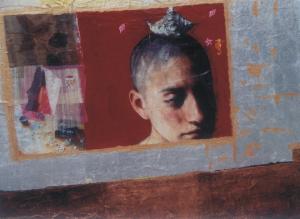Art
Simple, subtle and suave
Ina Rolshoven's exhibit at "La Galerie"
Fayza Haq
Talking about "Wounded Surface," an exhibition of paintings, installations and collage, Ina Rolshoven, a visiting artist from New York, who had her recent exhibit at "La Galerie", spoke at length about the details of her work and the reason behind her superb creations. Rolshoven explained that she came as a designer to work for MCC (Mennonite Centre Committee), a producer group in the countryside and to make up samples of crafts and any materials that will be useful like hand-made paper, basket, decorations for jute. MCC is an organisation that is dedicated to work for peace in more than 60 countries.Asked how Rolshoven, of German origin got in touch with MCC, she said that she had gone with a friend to Vietnam and this person was working for MCC. This was three years ago and while working in New York as an artist for three years, she decided to join the organisation. Ina had been working in New York for ten years, working as an artist and designer. She also worked for the Guggenheim Museum while she was there. Dwelling on her experiences in New York, Rolshoven said, that at first it was very challenging to adjust as life there as NY is a "fast" city and people there are very focused on their work. She said that as many artists live in NY there is a lot of inspiration and there is also a personal challenge. However, she enjoyed the pace there. Comparing her life in USA with that in Bangladesh, she said that she enjoyed the relative peace here and she would miss it sore as she was leaving it soon. She stayed in Mohammadpur, she said, and will always remember the place with nostalgia. She laughed when she was asked about the how she had taken to the rain, heat, dust, insects and poverty that went hand in hand with so many South East Asian metropolises. Rolshoven said, "Everything is in the mind; as my mind was peaceful here nothing bothered me; on other days when I was a bit nervous I found everything too much to accept. Everything depended on my inner requirements. I did miss home but I was lucky to have my mom visit me in January, I took her to all the MCC projects to the countryside near Syedpur. It was a very unusual experience for her as she's never been to the Subcontinent before. She enjoyed, as I'd done myself, the open, smiling and warm-hearted people there." Elaborating on her art pieces at "La Galerie" (that were geometrical collage works which included painting apart from her installations), Rolshoven said, "The rich and original expressions of Bangladeshi art has inspired her own work and she wished to share her experiences with her viewers through her work. If life only comprises of the image or reflection we see, it would surely be inane and blasť ; the texture of a painting parallel the harshness of life. It is the raw element of Bangladesh that gives it its spice. Only when we are able to see ourselves without the smoothness of deception, are we able to see anything at all. The art works may then become that object to which the onlooker can open himself/herself to examine. The 'Britto' artists, Nisar Hossain, and Ahmed Nazir of 'Chitrak' helped me specially with my work." One piece had shades, swirls and sections of turquoise and orange, sections of circles, splashes and collage of chocolate wrapping paper. The portions had been linked together with shaded bandages. These were done on cloth. Rolshoven said that they were collages on which she had been experimenting with since the last ten years. "I've been working around the theme of 'wound'," she said, "which stands for the 'slings and arrows' of life. I like the gauze for the bandaged effect, which has been dyed with tea and paint; the final effect is that of a map; I always work in layers of materials; my layers represent the human skin as well as a person's personality: you understand someone with more exposures to him/her. You grow to know a person a little at a time. The layers may also betaken as healing of wounds." Asked if US experience in Vietnam and that in Afghanistan and more recent one in Iraq had effected her work, Rolshoven said, "The series to the left of the gallery are images that I collected during the recent Iraqi happenings. The different faces that you see there have been collected at that time; they also represent my mother's experiences as a refugee during World War II. Germany began the war and that brought misery to the whole world. My main reason for joining MCC was my strong commitment for peace; MCC sent relief packages to Iraq when it was being bombed. As a foreigner in Bangladesh, I was questioned by onlookers in the streets and the faces you see there also include those of the local people. I'm always trying to connect various experiences along with those of my own. I want to share my experiences and try to understand the world." The piece that looked like some Rajasthani fabric work had bright, exotic colours splashed on it. It reminded one somewhat of Jackson Pollock's work. They were layers of cloth, paint and tinsels once, used "once more with feeling". Her installations too captured one's imagination; Rolshoven was bold and brave enough to include the portrait of a Bangladeshi who didn't quite accept her in her works. And thus she drove home the message of the global need for "pax" and understanding. Asked if she had left behind any friend in New York, Rolshoven said, "If it were so he would have been a very lonely man as I haven't been home for three years." The senior women painters in Dhaka admire her cooking and her mastery over "Rabindrasangeet".
|

Orphelia- 2001 |